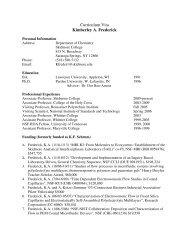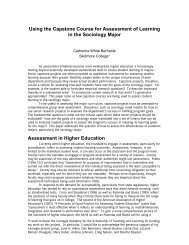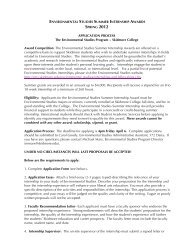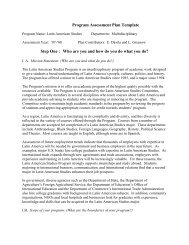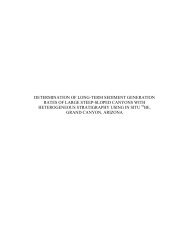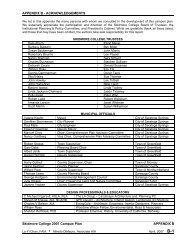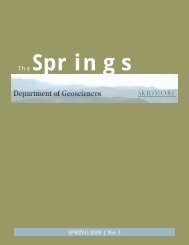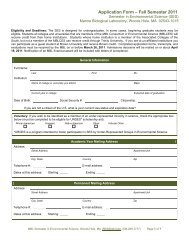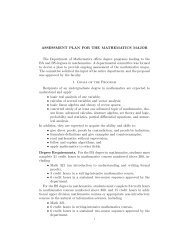ASSESSMENT PLAN Department of Marketing ... - Skidmore College
ASSESSMENT PLAN Department of Marketing ... - Skidmore College
ASSESSMENT PLAN Department of Marketing ... - Skidmore College
Create successful ePaper yourself
Turn your PDF publications into a flip-book with our unique Google optimized e-Paper software.
<strong>ASSESSMENT</strong> <strong>PLAN</strong><br />
<strong>Department</strong> <strong>of</strong> <strong>Marketing</strong><br />
<strong>College</strong> <strong>of</strong> Business<br />
Illinois State University<br />
MAJORS INCLUDED:<br />
<strong>Marketing</strong><br />
Integrated <strong>Marketing</strong> Communication Sequence<br />
Pr<strong>of</strong>essional Sales Sequence<br />
Summer 2006
TABLE OF CONTENTS<br />
INTRODUCTION............................................................................................... 1<br />
COMPONENTS OF THE <strong>ASSESSMENT</strong> ........................................................ 2<br />
Phase 1: Learning Objectives .................................................................. 2<br />
Learning Goals & Objectives for the <strong>Marketing</strong> Major ................. 2<br />
Learning Goals & Objectives for the <strong>Marketing</strong> Major<br />
Sequences (Integrated <strong>Marketing</strong> Communication (IMC)<br />
and Pr<strong>of</strong>essional Sales)............................................................. 3<br />
Phase 2: Measurement Via Content Tests and Rubrics ......................... 4<br />
Assessment <strong>of</strong> Content Knowledge................................................. 4<br />
Assessment <strong>of</strong> Skills Using the <strong>College</strong> Rubrics ............................ 4<br />
Assessment Data Points for the <strong>Marketing</strong> Major ......................... 4<br />
Assessment Data Points for the IMC Sequence ............................. 4<br />
Assessment Data Points for the Pr<strong>of</strong>essional Sales Sequence ....... 4<br />
Phase 3: Use <strong>of</strong> Data in Decision Making................................................ 5<br />
APPENDIX A: LEARNING GOALS OBJECTIVES FOR THE MAJORS.... 7<br />
APPENDIX B: SKILL BASED RUBRICS........................................................ 8<br />
Written Communication Rubric ............................................................. 9<br />
Oral Communication Rubric................................................................... 11<br />
Team Skills Rubric .................................................................................. 12<br />
Ethics Rubric ........................................................................................... 13
INTRODUCTION<br />
This document describes the assessment plan employed for the majors housed in the <strong>Department</strong><br />
<strong>of</strong> <strong>Marketing</strong> <strong>of</strong> the <strong>College</strong> <strong>of</strong> Business at Illinois State University. The plan describes the<br />
current status <strong>of</strong> the department as it moves toward a comprehensive assessment plan which will<br />
meet the requirements <strong>of</strong> AACSB International and the Illinois Board <strong>of</strong> Higher Education. This<br />
document provides guidelines for conducting assessment activities, outlines the assessment<br />
process and develops a schedule for implementing components <strong>of</strong> the plan.<br />
At its core, the assessment process provides data to be used to improve student learning. As<br />
such, information obtained during the process must be reviewed in a systematic, ongoing<br />
manner and should serve as the basis for subsequent decisions regarding the curriculum in the<br />
department. The focus <strong>of</strong> this plan will be on individual student outcomes and on providing<br />
information that can be used by program faculty to improve our major <strong>of</strong>ferings.<br />
1
COMPONENTS OF THE <strong>ASSESSMENT</strong> <strong>PLAN</strong><br />
The plan has three broad components as follows: (1) expected student learning outcomes as<br />
described by student learning goals and objectives; (2) a measurement component made<br />
operational via the use <strong>of</strong> rubrics and content tests; and (3) use <strong>of</strong> data to inform decision<br />
making. These components will each be described in the following sections.<br />
Phase 1: Learning Objectives<br />
Learning objectives for the various majors and sequences housed in the department were<br />
developed by the faculty in the MKT <strong>Department</strong>. Learning goals and objectives for each <strong>of</strong> the<br />
majors are as follows.<br />
Learning Goals & Objectives for the <strong>Marketing</strong> Major<br />
The faculty members teaching in the <strong>Marketing</strong> program have determined eight competency<br />
goals for their students.<br />
• <strong>Marketing</strong> Knowledge Base Competence<br />
o Each student has ownership <strong>of</strong> the requisite knowledge bases and tool sets <strong>of</strong> the<br />
<strong>Marketing</strong> discipline and can use their <strong>Marketing</strong> knowledge bases and tool sets to<br />
effectively address <strong>Marketing</strong> issues and problems.<br />
• Critical Thinking Competence<br />
o Each student can think critically in order to recognize, clarify, and analyze <strong>Marketing</strong><br />
situations, and make sound decisions and recommendations based upon the available<br />
information.<br />
• Communication Competence<br />
o Each student can effectively communicate using written and verbal formats.<br />
• Interpersonal Competence<br />
o Each student can demonstrate collaboration, leadership, and teambased decision<br />
making and exhibit pr<strong>of</strong>essional behavior.<br />
• <strong>Marketing</strong> Perspective Competence<br />
o Each student can identify, interpret, and evaluate the impact that controllable and<br />
uncontrollable environmental factors have on <strong>Marketing</strong> decisions.<br />
• Resource Capabilities Competence<br />
o Each student can assess resource (financial, human, intellectual, time) capabilities to<br />
implement <strong>Marketing</strong> decisions and recommendations.<br />
2
• Social Responsibility Competence<br />
o Each student has a basic understanding <strong>of</strong> ethical decision making models, can<br />
recognize potential ethical dilemma, utilize ethical reasoning skills to pr<strong>of</strong>essionally<br />
address and analyze consequences <strong>of</strong> unethical <strong>Marketing</strong> practices and decisions.<br />
• Information Technology Competence<br />
o Each student can identify opportunities to leverage technology in decision making.<br />
Learning Goals & Objectives for the <strong>Marketing</strong> Major sequences<br />
(Integrated <strong>Marketing</strong> Communication (IMC) and Pr<strong>of</strong>essional Sales)<br />
Faculty members in the MKT <strong>Department</strong> have determined seven goals that are shared by the<br />
three sequences in the <strong>Marketing</strong> major. The specific goals and objectives are detailed in<br />
Appendix A <strong>of</strong> this document.<br />
• <strong>Marketing</strong> Knowledge Base Competence<br />
o Each student has ownership <strong>of</strong> the requisite knowledge bases and tool sets specific to<br />
the sequence and can use these knowledge bases and tool sets to effectively address<br />
issues and problems.<br />
• Critical Thinking Competence<br />
o Each student can think critically in order to recognize, clarify, and analyze situations<br />
related to the sequence, and make sound decisions and recommendations based upon<br />
the available information.<br />
• Communication Competence<br />
o Each student can effectively communicate using written and verbal formats.<br />
• Interpersonal Competence<br />
o Each student can demonstrate collaboration, leadership, and teambased decision<br />
making and exhibit pr<strong>of</strong>essional behavior.<br />
• <strong>Marketing</strong> Perspective Competence<br />
o Each student can identify, interpret, and evaluate the impact that controllable and<br />
uncontrollable environmental factors have on <strong>Marketing</strong> decisions.<br />
• Resource Capabilities Competence<br />
o Each student can assess resource (financial, human, intellectual, time) capabilities to<br />
implement <strong>Marketing</strong> decisions and recommendations.<br />
3
Phase 2: Measurement Via Content Tests and Rubrics<br />
As described in the last section the <strong>Marketing</strong> program and its two sequences have a<br />
goal/objective focused on content, in addition to a number <strong>of</strong> objectives regarding skills. The<br />
sequences are in an early stage <strong>of</strong> development. The sequences have just been developed and<br />
recently approved by the University, thus we are three or four years away from seeing large<br />
numbers <strong>of</strong> students in the required classes. With work over the next Fall term (2006), we<br />
should have data collection mechanisms in place when students start the advanced courses in the<br />
revised program.<br />
The <strong>Marketing</strong> major has been doing content assessment for sometime but has not yet collected<br />
data on skills.<br />
Assessment <strong>of</strong> Content Knowledge<br />
An assessment vehicle covering content is currently being developed. This assessment vehicle is<br />
being developed in part from the different pre and postassessments the department developed<br />
for the required <strong>Marketing</strong> courses <strong>of</strong> MKT 230 – Introduction to <strong>Marketing</strong> Management, MKT<br />
231 – Buyer Behavior, MKT 232 – <strong>Marketing</strong> Research, and MKT 338 – Strategic <strong>Marketing</strong><br />
Management. This one content assessment instrument will be administered in the capstone,<br />
MKT 338 course.<br />
Assessment <strong>of</strong> Skills using the <strong>College</strong> rubrics<br />
The MKT department has agreed to pilot the <strong>College</strong> rubrics with some minor wording changes.<br />
The only exception is the Ethics rubric. Faculty felt uncomfortable with the current rubric in that<br />
it did not match the approach used to cover ethics in our classes (for example, the rubric has<br />
wording such as “…uses two or more ethical frameworks versus uses only one framework”).<br />
Thus we have tabled that rubric for the time being. Also note that the written communication<br />
rubric also contains components <strong>of</strong> critical thinking skills so this rubric may be used to evaluate<br />
both skill sets.<br />
The following section shows the places across the management sequences where data collection<br />
has occurred. The <strong>College</strong> skill rubrics can be found in Appendix B.<br />
Assessment data collection points for the <strong>Marketing</strong> Major:<br />
232: written communication, oral communication & team skills<br />
338: written communication, oral communication, critical thinking<br />
Assessment data collection points for the IMC Sequence:<br />
To be developed by May 2007<br />
Assessment data collection points for the Pr<strong>of</strong>essional Sales Sequence:<br />
To be developed by May 2007<br />
4
Phase 3: Use <strong>of</strong> Data in Decision Making<br />
MKT faculty from each sequence will meet during the month <strong>of</strong> October each year to review the<br />
assessment data collected during the prior academic year. Decisions regarding program changes<br />
will also be made at this time.<br />
Current rubrics will be used to inform decisions for the next two years during which time rubrics<br />
for the remaining skills will be developed. Once developed, these rubrics will be used for a two<br />
year period. The cycle will then be repeated and the department will return to the first set <strong>of</strong><br />
rubrics. Following is the timeline and cycle to be employed.<br />
Academic year Rubric refined & used Rubric development<br />
200607 Written communication Critical thinking<br />
200708 Oral communication Technology<br />
Team skills Diversity<br />
Ethics Globalization<br />
200809 Critical thinking<br />
200910 Technology<br />
Diversity<br />
Globalization<br />
201011 Written communication<br />
201112 Oral communication<br />
Team skills<br />
Ethics<br />
201213 Critical thinking<br />
201415 Technology<br />
Diversity<br />
Globalization<br />
2015 and beyond Cycle repeats<br />
5
APPENDIX A<br />
Learning Goals and Objectives<br />
For the Majors<br />
6
Undergraduate <strong>Marketing</strong> Majors’ Learning Goals<br />
<strong>Department</strong> <strong>of</strong> <strong>Marketing</strong><br />
Illinois State University<br />
• <strong>Marketing</strong> Knowledge Base Competence<br />
o Each student has ownership <strong>of</strong> the requisite knowledge bases and tool sets <strong>of</strong> the<br />
<strong>Marketing</strong> discipline and can use their <strong>Marketing</strong> knowledge bases and tool sets to<br />
effectively address <strong>Marketing</strong> issues and problems.<br />
• Critical Thinking Competence<br />
o Each student can think critically in order to recognize, clarify, and analyze <strong>Marketing</strong><br />
situations, and make sound decisions and recommendations based upon the available<br />
information.<br />
• Communication Competence<br />
o Each student can effectively communicate using written and verbal formats.<br />
• Interpersonal Competence<br />
o Each student can demonstrate collaboration, leadership, and teambased decision<br />
making and exhibit pr<strong>of</strong>essional behavior.<br />
• <strong>Marketing</strong> Perspective Competence<br />
o Each student can identify, interpret, and evaluate the impact that controllable and<br />
uncontrollable environmental factors have on <strong>Marketing</strong> decisions.<br />
• Resource Capabilities Competence<br />
o Each student can assess resource (financial, human, intellectual, time) capabilities to<br />
implement <strong>Marketing</strong> decisions and recommendations.<br />
• Social Responsibility Competence<br />
o Each student has a basic understanding <strong>of</strong> ethical decision making models, can<br />
recognize potential ethical dilemma, utilize ethical reasoning skills to pr<strong>of</strong>essionally<br />
address and analyze consequences <strong>of</strong> unethical <strong>Marketing</strong> practices and decisions.<br />
• Information Technology Competence<br />
o Each student can identify opportunities to leverage technology in decision making.<br />
7
APPENDIX B<br />
Skillbased Rubrics<br />
8
Goal: MKT<br />
<strong>College</strong> <strong>of</strong> Business<br />
Written Communication Rubric<br />
Criteria Unacceptable<br />
Levels<br />
Acceptable Exemplary<br />
Pr<strong>of</strong>essional<br />
Not formatted to specifications Formatting is generally correct, Assigned format followed<br />
Appearance and<br />
Lacking pr<strong>of</strong>essional<br />
acceptable pr<strong>of</strong>essional explicitly: Exceptional pr<strong>of</strong>essional<br />
Document Format (e.g.<br />
Appropriate binding,<br />
Headers/subheadings,<br />
margins, table <strong>of</strong><br />
contents, etc.)<br />
appearance.<br />
appearance.<br />
appearance<br />
Visual Presentation Very few or none: Not well Some used in a generally Appropriately used to effectively<br />
Elements (e.g. Charts, connected or integrated to effective manner to support the illustrate and support the document<br />
graph, exhibits, figures,<br />
etc.)<br />
support the document<br />
document<br />
Grammar and<br />
Frequent grammatical errors Few grammatical errors and Free <strong>of</strong> grammatical errors and<br />
Readability<br />
and misspellings inhibit misspellings (e.g. three or fewer misspellings<br />
(e.g. writing<br />
readability<br />
per page)<br />
Effective verb tense used<br />
mechanics/conventions) Informal language,<br />
Correct verb tense used Uses phrases and construction that<br />
abbreviations and slang are used Paragraphs flow from one to delight as well as inform the reader<br />
another<br />
Active voice pervasive<br />
Primarily active voice<br />
Breadth <strong>of</strong> Discussion Omits arguments or<br />
Covers the breadth <strong>of</strong> the topic Considers multiple perspectives<br />
perspectives<br />
without being superfluous Thoroughly delves into the<br />
Misses major content<br />
issues/questions<br />
areas/concepts<br />
Thoroughly discusses facts<br />
Presents few options<br />
relevant to the issues<br />
Depth <strong>of</strong><br />
Ignores bias<br />
Detects bias<br />
Analysis includes insightful<br />
Discussion<br />
Omits arguments<br />
Recognizes arguments<br />
questions<br />
Misrepresents issues<br />
Categorizes content<br />
Refutes bias<br />
Excludes data<br />
Paraphrase data<br />
Discusses issues thoroughly<br />
Includes but does not detect Sufficient detail to support Critiques content<br />
inconsistencies <strong>of</strong> information conclusions and/or<br />
Values information<br />
Ideas contain unnecessary gaps, recommendations<br />
Examines inconsistencies<br />
repetition or extraneous details<br />
Offers extensive detail to support<br />
Sees no arguments and<br />
conclusions and recommendations<br />
overlooks differences<br />
Suggests solutions or<br />
implementation<br />
9
10<br />
Levels<br />
Criteria Unacceptable Acceptable Exemplary<br />
Clarity Writing is not clear. It is<br />
difficult to understand points<br />
being made. The writing lacks<br />
transitions, and few examples<br />
and/or illustrations are provided<br />
to support explanation or<br />
recommendations.<br />
Relevance Critical issues/questions are<br />
omitted or ignored in the<br />
writing.<br />
Internal Consistency There is little integration across<br />
the sections <strong>of</strong> the paper.<br />
Several inconsistencies or<br />
contradictions exist. Few <strong>of</strong> the<br />
issues, recommendations and<br />
explanations make sense and<br />
are well integrated.<br />
Conclusion Fail to draw conclusions or<br />
conclusions rely on author’s<br />
authority rather than strength <strong>of</strong><br />
presentation<br />
Draws faulty conclusions<br />
References and Support<br />
<strong>of</strong> Discussion<br />
Shows intellectual dishonesty<br />
Omits research<br />
Reliance on direct quotes rather<br />
than integrating concepts into<br />
body <strong>of</strong> text Include biased<br />
sources<br />
Incomplete or missing<br />
bibliography<br />
Writing is generally well<br />
organized and understood.<br />
Transitions are used to facilitate<br />
clarity. Some examples<br />
and/illustrations are used to<br />
support explanation or<br />
recommendations.<br />
Most <strong>of</strong> the critical<br />
issues/questions are addressed in<br />
the writing.<br />
Sections <strong>of</strong> the paper are<br />
generally well linked/connected.<br />
Only minor contradictions exist.<br />
Most <strong>of</strong> the issues,<br />
recommendations and<br />
explanations make sense and are<br />
well integrated.<br />
Formulates clear conclusions<br />
with adequate support<br />
Adequate number <strong>of</strong> current<br />
sources References generally<br />
cited correctly<br />
Writing is succinct, precise,<br />
effectively organized and without<br />
ambiguity. Transitions,<br />
explanation and elaboration are<br />
extensive to elucidate points.<br />
Detailed illustrations and/or<br />
examples are used to support<br />
explanation or recommendations.<br />
All critical issues/questions are<br />
addressed completely in the<br />
writing.<br />
All sections <strong>of</strong> the paper are<br />
linked. There are no contradictions<br />
in the writing. All issues,<br />
recommendations and explanations<br />
make sense and are well integrated.<br />
Assimilates and critically reviews<br />
information, uses reasonable<br />
judgment, and provides balanced,<br />
well justified conclusions<br />
Shows intellectual honesty<br />
Attributes sources completely and<br />
properly<br />
Wide range <strong>of</strong> current and relevant<br />
sources used
Goal: MKT<br />
<strong>College</strong> <strong>of</strong> Business<br />
Oral Communication Rubric<br />
11<br />
Levels<br />
Criteria Unacceptable Acceptable Exemplary<br />
Organization Audience cannot understand or has<br />
trouble following presentation<br />
because student jumps around<br />
and/or there is no sequence <strong>of</strong><br />
information.<br />
Subject Knowledge Student does not have grasp <strong>of</strong><br />
information or is uncomfortable<br />
with information. Student can only<br />
answer rudimentary questions<br />
about the subject.<br />
Graphics Student uses superfluous graphics,<br />
no graphics, or graphics/visual aids<br />
that rarely support text and<br />
presentation. The graphics or<br />
visual aids are not clear or easily<br />
interpretable.<br />
Mechanics Student’s presentation has two or<br />
more spelling errors and/or<br />
grammatical errors.<br />
Eye Contact Student reads all or majority <strong>of</strong><br />
report; presentation is highly<br />
“canned’ and rigid; minimal or no<br />
eye contact throughout presentation<br />
Elocution The student’s voice lacks inflection<br />
and does not project well; student<br />
<strong>of</strong>ten mumbles or stumbles over<br />
words; there is frequent interjection<br />
<strong>of</strong> “crutch” words or sounds such<br />
as “ums,” “uhs,” “like,” “you<br />
know,” stuff,” etc.; words are<br />
mispronounced or word choice is<br />
<strong>of</strong>ten poor or incorrect.<br />
Student presents information in logical<br />
sequence which audience can follow.<br />
Student is at ease with the information<br />
and can answer expected questions but<br />
does not elaborate or go beyond a<br />
surfacelevel <strong>of</strong> knowledge.<br />
Student’s graphics or visual aids relate<br />
to the text and presentation.<br />
Presentation has no more than one<br />
misspelling and/or grammatical error.<br />
Student speaks and presents without<br />
reading, although may refer to notes or<br />
presentation materials occasionally;<br />
delivery exhibits some<br />
extemporaneous characteristics; eye<br />
contact is maintained and managed<br />
with total audience the majority <strong>of</strong> the<br />
presentation time.<br />
The student’s voice is clear and<br />
audible to all audience members and<br />
exhibits at least moderate inflection;<br />
there is minimal but some use <strong>of</strong><br />
“crutch” words or sounds such as<br />
“ums,” “uhs,” “like,” “you know,”<br />
stuff,” etc.; words are pronounced<br />
accurately and word choice is<br />
acceptable.<br />
Student presents information in<br />
logical, interesting sequence which<br />
audience can follow. There is a<br />
definite “flow” <strong>of</strong> the presentation<br />
from one topic to the next.<br />
Student demonstrates full<br />
knowledge (more than required) by<br />
answering all class questions with<br />
explanations and elaboration.<br />
Student’s graphics/visual aids<br />
explain and reinforce screen text and<br />
presentation, are creative, and help<br />
to distinguish the student’s<br />
presentation from other<br />
presentations.<br />
Presentation has no misspellings or<br />
grammatical errors. Sentences or<br />
phrases are clear and concise.<br />
Student speaks with little or no<br />
reference to notes or presentation<br />
materials; presentation appears very<br />
relaxed and nonscripted; eye<br />
contact is maintained and managed<br />
with total audience throughout the<br />
presentation.<br />
The student’s voice is clear and<br />
audible to all audience members and<br />
exhibits a high degree <strong>of</strong> inflection<br />
and precision; word choice is<br />
appropriate for the audience, well<br />
selected and interesting; words are<br />
pronounced correctly; use <strong>of</strong><br />
“crutch” words or sounds such as<br />
“ums,” “uhs,” “like,” “you know,”<br />
stuff,” etc. is seldom or nonexistent.
Goal: MKT<br />
<strong>College</strong> <strong>of</strong> Business<br />
Team Skills Rubric<br />
Criteria Unacceptable<br />
Levels<br />
Acceptable Exemplary<br />
Attendance Missed more than 20% <strong>of</strong> the Attended at least 80% <strong>of</strong> the team Attended at least 90% <strong>of</strong> the<br />
team meetings and/or was <strong>of</strong>ten meetings and was rarely, if team meetings and was ontime.<br />
late to meetings.<br />
ever, late.<br />
Participation Was mostly quiet in group<br />
meetings, or participated in an<br />
illinformed or otherwise non<br />
constructive manner.<br />
Effort Ended up doing significantly<br />
less than his/her fair share <strong>of</strong><br />
the work.<br />
Work Quality Completed assigned tasks either<br />
so late and/or so lacking in<br />
quality that other group<br />
members had to do significant<br />
additional work.<br />
Interpersonal<br />
Behaviors<br />
Exhibited a demeanor and<br />
interpersonal style that was<br />
intimidating, domineering,<br />
and/or nonsupportive and, thus,<br />
detracted from the team’s<br />
ability to work collaboratively.<br />
Came to meetings prepared and<br />
participated constructively in<br />
group discussions.<br />
Showed willingness and necessary<br />
effort to do his/her fair share <strong>of</strong> the<br />
work.<br />
Completed assigned tasks in a<br />
reasonably timely fashion and<br />
produced quality results that made<br />
meaningful contributions to<br />
the group’s work.<br />
Exhibited behaviors consistent<br />
with a collaborative group climate<br />
that fostered productive group<br />
outcomes including effective<br />
decision making and constructive<br />
disagreement.<br />
12<br />
Took a leadership role, came to<br />
meetings prepared and<br />
participated actively and<br />
constructively in group<br />
discussions.<br />
Willingly accepted his/her fair<br />
share <strong>of</strong> the team’s work and<br />
was appropriately proactive in<br />
taking on additional duties as<br />
needed.<br />
Completed tasks ontime and<br />
produced exceptional quality<br />
results that made outstanding<br />
contributions to the group’s<br />
work.<br />
Played a key role in creating a<br />
collaborative climate that<br />
fostered productive group<br />
outcomes including effective<br />
decision making and<br />
constructive disagreement.
Goal: MKT<br />
<strong>College</strong> <strong>of</strong> Business<br />
Ethic Rubric<br />
Criteria Unacceptable (1pt)<br />
Levels<br />
Acceptable (2pts) Exemplary (3pts)<br />
Students demonstrate Students unable to explain the Students identify and understand : Students apply an understanding<br />
an understanding <strong>of</strong> role <strong>of</strong> business in society. direct stakeholders when <strong>of</strong> direct and indirect<br />
the responsibility <strong>of</strong><br />
explaining the role <strong>of</strong> business stakeholders when examining<br />
business in society. Students understand monetary (treatment <strong>of</strong> employees, the role and responsibility <strong>of</strong><br />
role (pr<strong>of</strong>it maximization) <strong>of</strong> optimal firm value) in society. business in society.<br />
business in society.<br />
and<br />
indirect stakeholders when<br />
explaining the role <strong>of</strong> business<br />
(corporate citizenship,<br />
Stakeholders’ view) in society.<br />
Students demonstrate Students do not recognize an Students explore only two Students explore more than two<br />
an understanding <strong>of</strong> ethical situation exists. frameworks for assessing and frameworks for assessing and<br />
ethical decision<br />
evaluating an ethical situation. evaluating an ethical situation.<br />
making.<br />
Students use at most a single<br />
framework for assessing and<br />
evaluating an ethical<br />
situation.<br />
Students demonstrate Students show pre<br />
Students show conventional level Students show postconventional<br />
moral development in conventional level <strong>of</strong> moral <strong>of</strong> moral development<br />
level <strong>of</strong> moral development<br />
ethical decision development (deferring to (stereotypical roles <strong>of</strong> people in (morality based on “society as a<br />
making.<br />
authority and satisfying their society and how individual fits into whole” or “universal<br />
own needs).<br />
social order).<br />
principles”).<br />
Students demonstrate Students unable to explain the Students recognize leaders play Students recognize organization<br />
an understanding <strong>of</strong> role leaders in organization’s some role in the organization’s leaders’ actions and polices<br />
the responsibilities <strong>of</strong> ethical conduct.<br />
ethical conduct.<br />
determine the ethical tone <strong>of</strong> the<br />
a leader’s role as it<br />
relates to ethics.<br />
organization.<br />
Students demonstrate Students unable to identify Students recognize the<br />
Students apply appropriate<br />
an understanding <strong>of</strong> components <strong>of</strong> effective organization’s (code <strong>of</strong> conduct organization and external entity<br />
the roles <strong>of</strong> various corporate governance. and ethical culture) and external roles (code <strong>of</strong> conduct,<br />
corporate governance<br />
entities (government and<br />
pr<strong>of</strong>essional codes <strong>of</strong> conduct,<br />
entities and policies<br />
pr<strong>of</strong>essional organizations via laws laws and pr<strong>of</strong>essional codes <strong>of</strong><br />
as they relate to<br />
and pr<strong>of</strong>essional codes <strong>of</strong> conduct) conduct) when evaluating<br />
ethics.<br />
role in creating effective corporate<br />
governance.<br />
corporate governance.<br />
13



